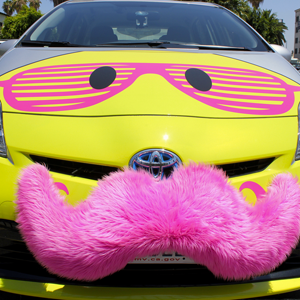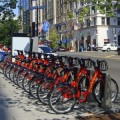The good booze ran out early and the freeloaders made a mess of the pink mustache cake. Not far off, inside the gardens of Villa Montalvo, two women dressed as angels stood on stilts and posed for pictures. In time, a three-piece bluegrass band replaced the angels on the brightly lit stage, and a few couples began to halfheartedly square dance. Pink mustaches were everywhere.
Depending on one’s perspective, the Silicon Valley launch party for Lyft, a peer-to-peer ridesharing service, was a celebration of something quirky and new and disruptive. But had part of the old guard been invited to the event, it wouldn’t be far-fetched for a few cab drivers to view the whole occasion as crass—a wake before the taxi industry’s funeral.
Lyft’s logo, the furry pink mustache, has seemingly become ubiquitous overnight, now present on the grills of cars in San Francisco and 16 other markets across the country—including San Jose, which was added earlier this month with the rest of Silicon Valley. The privately held startup, created in July 2012, tallied its millionth ride via app in August. It is one of several ridesharing services that have migrated south from San Francisco to challenge established cab companies, which have controlled markets through licensed arrangements that could be becoming anachronistic.
Dmitri Vorik, president of Rainbow Cab Company in San Jose, estimates that Lyft, Uber and other ridesharing services have cut into his business by 30 percent. But his complaints—and there were many—go beyond just new competition, at times indistinguishable from other passenger vehicles. Taxis in San Jose are not only required to pay permit fees to work at the airport, they also have multiple bureaucratic hoops to jump through each year.
“Anybody who does a commercial operation with wheels at the airport has to get this ground transportation license,” Vorik says. “I sent [the city] an application for a shopping cart—anything with wheels, you know—they got pissed about that.”
Vorik’s drivers received 33 tickets for noncompliance in September, he says, each for $250 dollars. The city fee is $5 per trip in and out of the airport, he adds, which seriously cuts into drivers’ bottom line. In protest, the top of Rainbow’s cabs have advertisements that read, “Fly SFO. The REAL Airport.”
With lower operating costs and fewer regulations, Vorik predicts that rideshare companies, which basically sponsor approved drivers to turn their vehicles into a part-time taxi, will eventually kill licensed cab companies.
“That’s not really what were looking to do, we’re not looking to hurt the taxi industry,” says Paige Thelan, a communications coordinator for Lyft. “We think there’s plenty of room in the playing field.”
But some of the benefits of ridesharing—faster pickup, cheaper costs, friendlier service and technical ease—could come with an unintended consequence. Similar to concerns voiced by community activists in San Francisco, Larry Silva, owner of Yellow Checker Cab in San Jose, says the increase in peer-to-peer services could actually hurt seniors and low-income communities.
“These companies don’t cater to people with no smartphones, no credit cards,” Silva says. “When taxi drivers get replaced by these rideshare services, who’s going to provide service to these populations?”
In May, cabbies in San Francisco circled City Hall and honked their horns in protest during a transportation meeting on ridesharing. SF Weekly reported that taxi drivers feel the new apps are skimming the “cream” off their business, leaving little more than the less affluent fares.
That isn’t to say local cab companies are completely behind the times.
“We do have our own app and regular users,” Silva says. “We’re one of the original cab companies with an app system, Taxi Magic.”
The app, which has mostly positive reviews, allows users to see nearby cabs on a map and track their progress after being hailed. So far, Silva says, Yellow Checker has not seen a drop-off in business. But, he adds, “I wouldn’t say that we’re not going to.”
Though new to the South Bay, ridesharing services are anything but in the Bay Area. Uber, initially called UberCab, began the trend in 2010 by providing town cars and limousines for dispatch in San Francisco via app. Pricier than a cab, Uber gained popularity for its convenience and comfort. Other companies, like Lyft and Sidecar, took app dispatch to the next level by connecting amateur drivers in their own vehicles to passengers in need of rides, and Uber launched a similar service, UberX, in response.
For Lyft, after completing the trip, both driver and passenger can rate each other and a suggested “donation” to the driver is recommended by the app—a bit of an equivocation the company uses to deny it provides any transportation for hire. Of course, the donation is optional, but the resulting ratings are serious: cheapskates will be outed and low-rated drivers will be passed over.
Almost as easily as getting a ride on Lyft is signing up to drive—a far cry from the hoops cab companies must jump through. The city of San Jose currently regulates and permits taxis through the police department. The company must hold a business license, and the cab drivers are required to have their own business license and fingerprints on file, plus take a written test, a background check and a drug test. For a new driver, a San Jose Police Department spokesperson says, it costs about $464 to get all these tasks completed. For a returning driver it costs $137.
Compare this to the Lyft application: Submit a few documents online without charge and watch a video about the community that Lyft is building. The fist bump that every driver and passenger in a Lyft vehicle traditionally exchange gives off a casual vibe. But the disruption caused by ridesharing services could be approaching a bureaucratic speed bump.
The California Public Utilities Commission (CPUC) recently took initial regulatory action on ridesharing startups, or transportation network companies (TNCs), as they’ve dubbed them. While taxis are regulated at the local level, the CPUC regulates charter party carriers, or prearranged forms of transport like limousines. The CPUC recently required that all TNCs obtain a license, conduct criminal background checks, establish a driver-training program and hold a commercial insurance policy with a minimum of $1 million per-incident coverage.
Thelan says Lyft already had these self-imposed rules on the books, so there has been little to no impact on the company.
At the local level, the city of San Jose and SJPD are still waiting to see how things shake out before implementing any of their own regulations. The airport intends to require permits from TNC drivers, but it recognizes that the unmarked personal vehicles may make enforcement difficult. Airport spokesperson Vicki Day says that one of the state’s new requirements for TNCs is to “display consistent trade dress” (i.e. distinctive signage) on the vehicles.
The CPUC’s recent actions have been seen by some as a classic example of a nimble, self-regulating startup being absorbed into the political morass that so many tech companies seek to avoid. The CPUC emphasized in its regulatory decision that it does not want to quash innovation in transportation, but took action due to public safety concerns.
For Vorik and other cab drivers in San Jose, their anxieties remain focused on the imminent economic threat posed by ridesharing services. “They’re gonna kill licensed cab companies eventually,” Vorik says.
Before he gets off the phone, Vorik says he’s going hunting in the Central Valley for the weekend. “I need to kill something for stress relief.”

 Review: Paesano Ristorante Italiano
Review: Paesano Ristorante Italiano 







